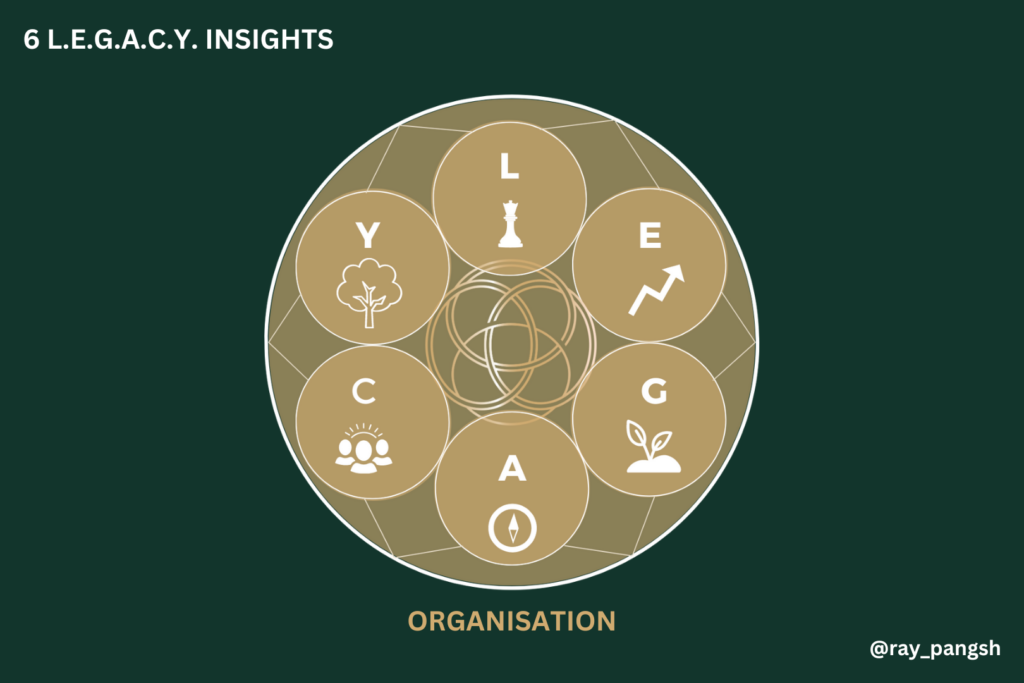Change Your Mindset
The 6 L.E.G.A.C.Y. Insights: Building A Holistic Approach To Business

In the complex and rapidly evolving landscape of modern business, innovative models are the need of the hour to navigate challenges and maintain sustainable growth. Inspired by the metaphor of the ‘Earth as a Cosmic Playground’, the LEGACY Impact System has emerged as a beacon of guidance, interconnecting six crucial business elements to create a comprehensive roadmap towards sustainable success.
LEADERSHIP – Conscious Leadership
Simon Sinek, a world-renowned optimist and visionary, once stated, “Leadership is not about being in charge. It is about taking care of those in your charge.” Conscious leadership embodies this principle, prioritising awareness of the broader implications and ripple effects of decisions on the organisation, its stakeholders, and the environment.
Action Steps:
- Leadership Training: One of the foundational steps towards conscious leadership is investing in leadership development programs that highlight ethical decision-making, environmental stewardship, and social responsibility. These training programs should encompass elements such as emotional intelligence, transparency, empathy, and long-term thinking, equipping leaders to guide their teams towards sustainable growth.
- Stakeholder Engagement: Conscious leaders also emphasise consistent and open dialogue with stakeholders. By incorporating stakeholders’ insights into decision-making processes, leaders can ensure they’re addressing the needs and concerns of those impacted by the organisation’s operations.
EVOLUTION – Adaptability
Like the ever-evolving cosmos, businesses must be capable of change and evolution. Albert Einstein’s wisdom encapsulates this requirement: “The measure of intelligence is the ability to change.” In the fast-paced business world, adaptability becomes an essential survival trait, fostering resilience and agility.
Action Steps:
- Innovation Encouragement: Businesses can nurture adaptability by creating an environment that celebrates innovation, rewards creative problem-solving, and supports calculated risk-taking. This could involve implementing an open-door policy for ideas, organising brainstorming sessions, or establishing an innovation hub within the organisation.
- Technology Integration: Keeping abreast of technological advancements and incorporating them into business processes is another critical step. This proactive approach not only optimises operations but also positions the organisation as a forward-thinking player in the industry.
GROWTH – Continuous Learning and Development
Motivational speaker and writer Leo Buscaglia said, “Change is the end result of all true learning.” In the realm of business, this translates into the equation ‘continuous learning equals continuous growth’. Organisations that champion a culture of ongoing learning and development are well-positioned to thrive.
Action Steps:
- Employee Training: Regular training and development opportunities should be provided to employees to update their skills and stay abreast of industry trends. This can range from skills-based workshops and webinars to providing resources for self-learning and personal development.
- Learning Culture: Promoting a culture that values learning and improvement at all levels of the organisation is crucial. This can be achieved by recognising and rewarding learning initiatives, encouraging feedback, and fostering an atmosphere of open communication.
ALIGNMENT – Holistic Approach to Business and Value-Based Marketing
Renowned systems scientist Peter Senge stated, “Alignment is the prerequisite for effectiveness.” Taking inspiration from the cosmos, where every element is harmoniously aligned, businesses should ensure all aspects of their operations align with their core mission and values.
Action Steps:
- Internal Alignment: To ensure coherence between what a business says and does, internal processes, practices, and culture should reflect the organisation’s mission and values. This includes aligning recruitment and management practices, employee benefits, and internal communication with the organisation’s core ethos.
- External Alignment: Similarly, marketing, customer service, and branding strategies should resonate with the organisation’s values. Authentic alignment in these areas fosters trust among stakeholders and differentiates the business in a competitive marketplace.
Ready to Learn to Unlock The Power of Emotional Intelligence and Win More Clients?
COMMUNITY – Community Building
Civil rights activist Coretta Scott King once stated, “The greatness of a community is most accurately measured by the compassionate actions of its members.” This statement holds significant relevance for modern businesses, underlining the importance of community-building among stakeholders.
Action Steps:
- Stakeholder Inclusion: Businesses can foster community by including stakeholders in decision-making processes, fostering a sense of ownership and engagement. This can be facilitated through town-hall meetings, feedback sessions, and collaborative projects.
- Engagement Initiatives: Launching initiatives that promote interaction and collaboration among stakeholders can further strengthen community bonds. These initiatives can range from team-building activities and social events to forums for sharing ideas and challenges.
YIELD – Sustainability and Technology Integration
Danish architect Bjarke Ingels pointed out that sustainability should not be viewed as a sacrifice but as a design challenge. Businesses, similarly, should see sustainability as an essential aspect of their design and operational strategies, not as an afterthought.
Action Steps:
- Sustainable Practices: By incorporating sustainability into every facet of business operations, from product design and manufacturing to supply chain management and waste disposal, businesses can make a positive impact on the environment and society.
- Tech-driven Sustainability: Technology offers a myriad of ways to enhance sustainability. By harnessing technology to optimise resource use, reduce energy consumption, or streamline processes, businesses can demonstrate their commitment to sustainable practices.

In conclusion, the 6 L.E.G.A.C.Y. Insights offer a holistic and actionable guide for businesses looking to navigate the complexities of today’s dynamic business landscape. By integrating conscious leadership, adaptability, continuous learning and development, alignment, community building, and sustainability into their day-to-day operations, organisations can achieve sustainable growth and contribute positively to the larger cosmic playground.
Ray Pang SH has generated over USD$1.216mil for his business using the Transformational Sales Methods he discussed above and in his other articles on A2S.
Want to work with him and become one of the 125+ business owners he has helped generate over USD$12.164mil in sales for? Go to his Instagram here and DM him the word “LEGACY” to learn how he can revolutionise your business now.
Want to Master Sales? Find out what it takes for you to become a master salesman
Change Your Mindset
Peter Drucker’s Life Lessons Every Leader Needs to Hear
He believed life had no meaning if it was only about work

Peter Drucker is widely celebrated as the father of modern management. But beyond his groundbreaking theories and contributions to business thinking, Drucker lived a remarkably full and meaningful life, one that offers powerful lessons on leadership, balance, time management, and the pursuit of purpose. (more…)
Change Your Mindset
The Leadership Skill Nobody Talks About (But Changes Everything)
Curiosity often takes a back seat to certainty and gets labeled as a soft skill, which makes it sound obvious and easy

Most of us, when faced with challenges, instinctively seek certainty and answers. In turn, our ego steps in and prompts us to defend our views, double down, or perhaps disengage. (more…)
Personal Development
Want to Change the World? Start by Sharing Your Knowledge
When we’re exposed to new perspectives, our thinking expands, and so does our potential to create

The Power of Ideas
In October 1904, during a thirty-six-hour train journey from Johannesburg to Durban, Mahatma Gandhi read Unto This Last by John Ruskin, a book that would radically alter the course of his life. Reflecting on that night, Gandhi said, “I could not get any sleep. I was determined to change my life by the ideals of the book.” (more…)
Personal Development
Burned Out at Your Desk? Try This 5-Minute Mental Reset
This kind of fatigue doesn’t always feel dramatic, but it’s deadly for momentum

-

 Success Advice4 weeks ago
Success Advice4 weeks agoThe One Mindset Shift That Made Me Irreplaceable At Work
-

 Did You Know3 weeks ago
Did You Know3 weeks ago7 Surprising Life Lessons Video Games Taught Me That School Never Did
-

 Success Advice3 weeks ago
Success Advice3 weeks agoHow Playing by the Rules Became the Smartest Business Strategy
-

 Success Advice3 weeks ago
Success Advice3 weeks agoHow to Build Trust, Kill Micromanagement, and Lead a Team That Thrives
-

 Scale Your Business3 weeks ago
Scale Your Business3 weeks agoHow to Build a Workplace People Actually Want to Show Up To
-

 Success Advice2 weeks ago
Success Advice2 weeks agoSuccess Isn’t Sexy: 5 Daily Habits That Actually Work
-

 Scale Your Business2 weeks ago
Scale Your Business2 weeks agoHow Smart Entrepreneurs Cut Financial Chaos in Half with One Simple Switch
-

 Success Advice2 weeks ago
Success Advice2 weeks agoBreaking the Bias: How Females Can Thrive In The Workplace in 2025

















